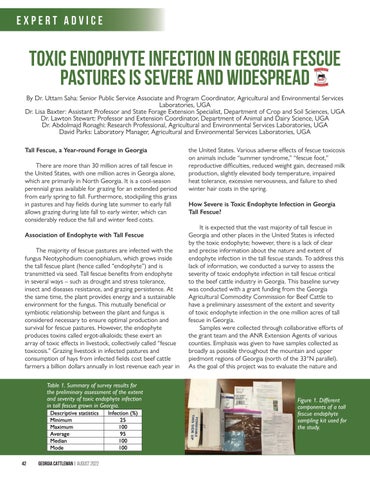Expert advice
Toxic Endophyte Infection in Georgia Fescue Pastures is Severe and Widespread By Dr. Uttam Saha: Senior Public Service Associate and Program Coordinator, Agricultural and Environmental Services Laboratories, UGA Dr. Lisa Baxter: Assistant Professor and State Forage Extension Specialist, Department of Crop and Soil Sciences, UGA Dr. Lawton Stewart: Professor and Extension Coordinator, Department of Animal and Dairy Science, UGA Dr. Abdolmajd Ronaghi: Research Professional, Agricultural and Environmental Services Laboratories, UGA David Parks: Laboratory Manager, Agricultural and Environmental Services Laboratories, UGA Tall Fescue, a Year-round Forage in Georgia There are more than 30 million acres of tall fescue in the United States, with one million acres in Georgia alone, which are primarily in North Georgia. It is a cool-season perennial grass available for grazing for an extended period from early spring to fall. Furthermore, stockpiling this grass in pastures and hay fields during late summer to early fall allows grazing during late fall to early winter, which can considerably reduce the fall and winter feed costs. Association of Endophyte with Tall Fescue The majority of fescue pastures are infected with the fungus Neotyphodium coenophialum, which grows inside the tall fescue plant (hence called “endophyte”) and is transmitted via seed. Tall fescue benefits from endophyte in several ways – such as drought and stress tolerance, insect and diseases resistance, and grazing persistence. At the same time, the plant provides energy and a sustainable environment for the fungus. This mutually beneficial or symbiotic relationship between the plant and fungus is considered necessary to ensure optimal production and survival for fescue pastures. However, the endophyte produces toxins called ergot-alkaloids; these exert an array of toxic effects in livestock, collectively called “fescue toxicosis.” Grazing livestock in infected pastures and consumption of hays from infected fields cost beef cattle farmers a billion dollars annually in lost revenue each year in Table 1. Summary of survey results for the preliminary assessment of the extent and severity of toxic endophyte infection in tall fescue grown in Georgia.
42
GEORGIA CATTLEMAN | AUGUST 2022
the United States. Various adverse effects of fescue toxicosis on animals include “summer syndrome,” “fescue foot,” reproductive difficulties, reduced weight gain, decreased milk production, slightly elevated body temperature, impaired heat tolerance, excessive nervousness, and failure to shed winter hair coats in the spring. How Severe is Toxic Endophyte Infection in Georgia Tall Fescue? It is expected that the vast majority of tall fescue in Georgia and other places in the United States is infected by the toxic endophyte; however, there is a lack of clear and precise information about the nature and extent of endophyte infection in the tall fescue stands. To address this lack of information, we conducted a survey to assess the severity of toxic endophyte infection in tall fescue critical to the beef cattle industry in Georgia. This baseline survey was conducted with a grant funding from the Georgia Agricultural Commodity Commission for Beef Cattle to have a preliminary assessment of the extent and severity of toxic endophyte infection in the one million acres of tall fescue in Georgia. Samples were collected through collaborative efforts of the grant team and the ANR Extension Agents of various counties. Emphasis was given to have samples collected as broadly as possible throughout the mountain and upper piedmont regions of Georgia (north of the 33°N parallel). As the goal of this project was to evaluate the nature and
Figure 1. Different components of a tall fescue endophyte sampling kit used for the study.













